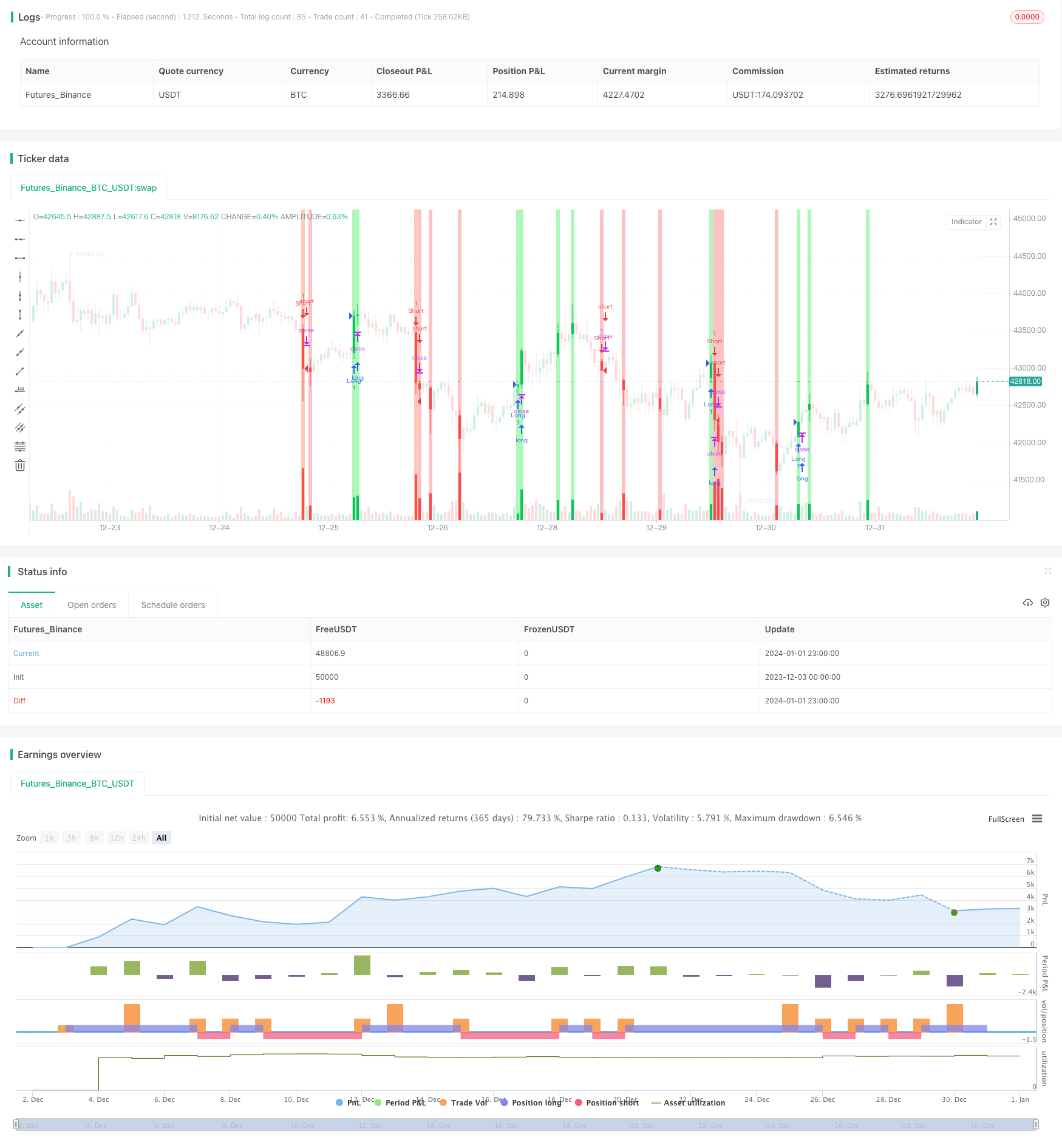ATR Channel Breakout Trend-following Strategy
Author: ChaoZhang, Date: 2024-01-03 11:53:52Tags:

Overview
This strategy utilizes the ATR channel and breakout theory to follow trends by entering when the channel is broken. It belongs to trend-following strategies. The strategy is simple and easy to understand, using moving average channels and ATR indicators to determine trend direction and issuing trading signals at key points.
Principle
This strategy constructs upper and lower bands with high, low, close prices and ATR indicator to form an ATR channel. The channel width is determined by the ATR parameter size. When the price breaks through the channel, it is judged as the beginning of a trend, at which points long or short positions are entered. The strategy has two tiers of trading signals. When the price breaks through one ATR width, it is considered as an emerging trend, triggering the first tier of buy/sell points. When the price breaks through two ATR widths, it is considered an accelerating trend, triggering the second tier of buy/sell points.
Advantage Analysis
The main advantages of this strategy are:
- Using ATR indicators to construct channels considers market volatility better than simple moving averages.
- The two-tier buy/sell points allow staged entry with controllable risks.
- Breakout theory accurately locates key trend points.
- The concise code is easy to understand and implement.
Risk Analysis
The main risks of this strategy are:
- Reliance on a single indicator means high failure probability if ATR fails.
- Lack of stop loss and position management leads to insufficient risk control.
- Utility needs verification and may underperform in live trading conditions.
- Improper parameters may cause whipsaws or overtrading.
Optimization Directions
The optimization directions for this strategy include:
- Adding filters with multiple indicators to prevent misjudgments.
- Adding stop loss modules to enhance risk control.
- Adding position control and money management.
- Parameter tuning for different products.
- Reducing trading frequency and position sizing for live trading.
Summary
The overall framework of this strategy is clear and usable as a proof of concept. But there are gaps from live trading that allow substantial optimizations. If risk controls and trading frequencies can be further improved, the application prospects would be good.
/*backtest
start: 2023-12-03 00:00:00
end: 2024-01-02 00:00:00
period: 1h
basePeriod: 15m
exchanges: [{"eid":"Futures_Binance","currency":"BTC_USDT"}]
*/
// This Pine Script™ code is subject to the terms of the Mozilla Public License 2.0 at https://mozilla.org/MPL/2.0/
// © Myhaj_Lito
//@version=5
strategy("Renko Trend Strategy",shorttitle = "RENKO-Trend str.",overlay = true)
TF = input.timeframe(title='TimeFrame', defval="60")
ATRlength = input.int(title="ATR length", defval=60, minval=2, maxval=1000)
HIGH = request.security(syminfo.tickerid, TF, high)
LOW = request.security(syminfo.tickerid, TF, low)
CLOSE = request.security(syminfo.tickerid, TF, close)
ATR = request.security(syminfo.tickerid, TF, ta.atr(ATRlength))
RENKOUP = float(na)
RENKODN = float(na)
H = float(na)
COLOR = color(na)
BUY = int(na)
SELL = int(na)
UP = bool(na)
DN = bool(na)
CHANGE = bool(na)
RENKOUP := na(RENKOUP[1]) ? (HIGH + LOW) / 2 + ATR / 2 : RENKOUP[1]
RENKODN := na(RENKOUP[1]) ? (HIGH + LOW) / 2 - ATR / 2 : RENKODN[1]
H := na(RENKOUP[1]) or na(RENKODN[1]) ? RENKOUP - RENKODN : RENKOUP[1] - RENKODN[1]
COLOR := na(COLOR[1]) ? color.white : COLOR[1]
BUY := na(BUY[1]) ? 0 : BUY[1]
SELL := na(SELL[1]) ? 0 : SELL[1]
UP := false
DN := false
CHANGE := false
// calculating
if not CHANGE and close >= RENKOUP[1] + H * 2
CHANGE := true
UP := true
RENKOUP := RENKOUP[1] + ATR * 2
RENKODN := RENKOUP[1] + ATR
COLOR := color.rgb(0, 255, 170,60)
SELL := 0
BUY += 2
BUY
if not CHANGE and close >= RENKOUP[1] + H
CHANGE := true
UP := true
RENKOUP := RENKOUP[1] + ATR
RENKODN := RENKOUP[1]
COLOR := color.rgb(0, 230, 38,60)
SELL := 0
BUY += 1
BUY
if not CHANGE and close <= RENKODN[1] - H * 2
CHANGE := true
DN := true
RENKODN := RENKODN[1] - ATR * 2
RENKOUP := RENKODN[1] - ATR
COLOR := color.rgb(255, 92, 43,60)
BUY := 0
SELL += 2
SELL
if not CHANGE and close <= RENKODN[1] - H
CHANGE := true
DN := true
RENKODN := RENKODN[1] - ATR
RENKOUP := RENKODN[1]
COLOR := color.rgb(245, 69, 69,60)
BUY := 0
SELL += 1
SELL
//// STRATEGY
if(UP)
strategy.entry("Long",strategy.long)
if(DN)
strategy.entry("Short",strategy.short)
// ploting
bgcolor(COLOR)
- Short-term Trend Tracking Strategy Based on Gann Me Analysis Indicator
- The Gaussian Moving Average Trading Strategy
- Adaptive Kaufman Moving Average Trend Following Strategy
- Bandpass Filtering Trend Extraction Strategy
- Dual Reversal High-Low Strategy
- Heyping Moving Average Trend Strategy
- Long and Short Opening Strategy Based on Multi Timeframe Moving Average and MACD
- Momentum Indicator RSI Reversal Trading Strategy
- Double Bollinger Band Breakout Strategy
- Automatic Tracking Trend Strategy Based on T3 and ATR
- MACD 200 Day Moving Average Crossover Trading Strategy
- Golden Cross Uptrend Tracking Strategy
- Dual EMA Crossover Oscillation Tracking Strategy
- Stiffness Breakthrough Strategy
- Sideways Breakthrough Oscillation Strategy
- Quantitative Trading Strategy Based on RSI Indicator and Engulfing Pattern
- Bollinger Bands ATR Trailing Stop Strategy
- Daily Breakout Strategy
- Signal-to-Noise Moving Average Trading Strategy Based on Quantitative Trading
- Momentum Crossover Moving Average and MACD Filter Heikin-Ashi Candlestick Strategy